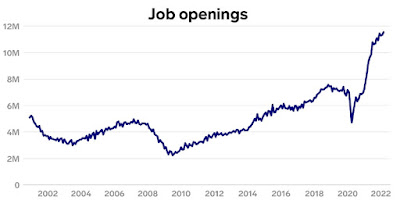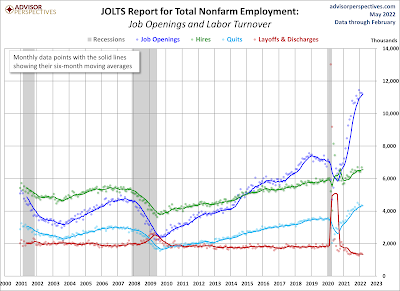March JOLTS report: the game of musical chairs in the jobs market intensifies to all-time highs In March, as this morning’s Census Bureau JOLTS report shows, the game of musical job chairs in the jobs market has actually intensified to all-time levels. Specifically, both job openings and quits made all-time highs, and total separations during their entire 20 year history were only higher in March and April 2020. As a refresher, some months ago I introduced the idea that the jobs market was like a game similar to musical chairs, where employers added or took away chairs, and employees tried to best allocate themselves among the chairs. Because of the pandemic, there are several million fewer players trying to sit in those chairs, leaving many
Topics:
NewDealdemocrat considers the following as important: jobs market, US EConomics
This could be interesting, too:
NewDealdemocrat writes JOLTS revisions from Yesterday’s Report
Bill Haskell writes The North American Automobile Industry Waits for Trump and the Gov. to Act
Bill Haskell writes Families Struggle Paying for Child Care While Working
Joel Eissenberg writes Time for Senate Dems to stand up against Trump/Musk
March JOLTS report: the game of musical chairs in the jobs market intensifies to all-time highs
In March, as this morning’s Census Bureau JOLTS report shows, the game of musical job chairs in the jobs market has actually intensified to all-time levels. Specifically, both job openings and quits made all-time highs, and total separations during their entire 20 year history were only higher in March and April 2020.
As a refresher, some months ago I introduced the idea that the jobs market was like a game similar to musical chairs, where employers added or took away chairs, and employees tried to best allocate themselves among the chairs. Because of the pandemic, there are several million fewer players trying to sit in those chairs, leaving many empty. As a result, wages have continued to increase sharply, as employers attempt to attract potential employees to sit in the continuing big number of empty chairs. I’ve followed up by positing that the game of musical chairs will only slow down once some employers throw in the towel, and the number of job openings significantly declines. As noted above, in March the opposite happened.
To the numbers . . .
Layoffs and discharges (violet, right scale in the graph below) rose 51,000 to 1.405 million, a 6 month high, versus their record low of 1.262 in December. Total separations (blue) rose 239,000 to 6.321 million (graph starts in June 2020 for reasons of scale):
[Note: FRED inexplicably hasn’t updated with today’s data yet. I’ll update this post once they do. In the meantime, below I’ve copied similar graphs from other sources/]

On a historical level, layoffs still continue to be very low.
Meanwhile, job openings (blue in the graph below) rose 205,000 to 11.549 million, a new all-time high. Previously openings had appeared to be leveling off after gradually increasing to repeated record highs. Voluntary quits (the “great resignation,” gold, right scale) rose 52,000 to 4.536 million, also following a period of apparent leveling off. Actual hires (red) declined 95,000 from February’s revised all-time high of 6.832 million to 6.737 million:

In summary, and to reiterate, the message of these numbers is that the competition by employers to attract employees has only intensified. Because of the continuing yawning gap, wages have continued and should continue to soar. As shown in the below graph of job openings divided by actual hires (blue, right scale), where 1.0 represents the level at which the number of openings and hires are equal, in the last 18 months this ratio has repeatedly made new all-time highs.
Thus I expect this Friday’s jobs report to show that wages continue to rise at a very strong pace, even though the slowing in consumer spending growth points toward weaker monthly gains in the number of jobs.
